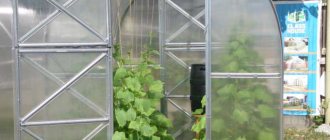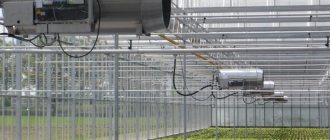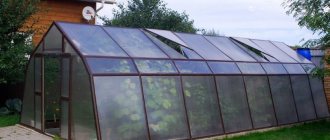The fundamental difference between a greenhouse and a greenhouse is that the first of the structures is heated by natural means, but heating the second will require the installation of an artificial heating system. Its device can be implemented in several ways. You can install electric, water or gas heating. Each of these methods has its own disadvantages and advantages. But for heating a small greenhouse, it is most advisable to use gas.
Gas is a flammable explosive, therefore heating a greenhouse with gas requires seeking help from specialists. Don't neglect this!
Heating a greenhouse is a necessary condition for growing various crops in it.
To ensure sufficient heating in autumn and spring, the most optimal method is that which is carried out using gas, since the installation of a water or electrical system under such conditions is difficult to call appropriate.
If the room is small, then there is no need to connect the heating system to the central gas supply line. You can buy gas cylinders, which will provide heating. The cylinders can simply be connected to a self-regulating heating system. A seasonal greenhouse can be heated using bottled gas; the heat they can provide is quite sufficient. Also, with gas heating, carbon dioxide and water vapor enter the room, and these substances contribute to the active growth of seedlings.
Basic Rules
In greenhouses with a large area, it is necessary to connect to a common gas pipeline network; small greenhouses can be heated with gas cylinders.
To heat a room with gas, you can use various heating equipment: gas burners or air heaters. Each of them has its own characteristics. Using burners is more dangerous. However, provided that there are no wooden elements in the greenhouse structure, you can resort to burners. In this case, the burners simply need to be connected to cylinders and placed throughout the entire area of the room requiring heating. Installing a heating system requires a lot of expense and effort, but this option will prove to be more convenient to use in the future.
Particular attention must be paid to the uniform distribution of heat in the room, as this represents the greatest difficulty when organizing gas heating. To do this, you need to connect a sufficient number of burners to the gas cylinder, which will be distributed evenly throughout the room. At the same time, providing gas heating to a greenhouse requires compliance with certain safety measures. For example, access to gas burners should not be hampered in any way. If any problems occur in their operation, it should be possible to turn them off immediately. In addition, gas equipment requires constant preventive maintenance.
Heating using gas requires an efficient ventilation system. A hood may need to be installed. This is due to the fact that gas heating leads to a lack of oxygen over time.
The advantage of air heaters is that they are able to provide a sufficient amount of heat and at the same time mix the heated air. Their only drawback is their high cost. First of all, costs will be required for the installation of polyethylene perforated pipes, which should form an entire system. In addition, it is necessary to install a chimney that will ensure the removal of combustion products from the room.
Classic version
The traditional approach to using gas to ensure an optimal microclimate in greenhouses involved the creation of a heat circuit based on a gas boiler. This method is effective and reliable, but it is not very suitable for a small private greenhouse; the financial investment turns out to be impressive; it is necessary to create complex pipe routings and install shut-off valves for fine tuning and adjustment of functioning. In addition, this method of gas heating requires obtaining numerous certificates and permits; the equipment is classified as potentially dangerous, and therefore requires approval from regulatory authorities.
As a result, this scheme is relevant only if we are talking about a large commercial greenhouse with an area of several hundred square meters. Then we can talk about the justification of all investments, they are quickly compensated. Creating a separate heating circuit for a small agricultural structure is only appropriate if the owners use a gas boiler to heat the main cottage; it is possible to make a branch to the greenhouse.
Some features
When heating a greenhouse with gas, oxygen burns out and burns out, which is dangerous for plants, so ventilation/air supply systems must also operate simultaneously with gas heating.
Heating a greenhouse with gas means turning to specialists for help. Do not neglect this, as gas is a flammable and explosive substance. Failure to take the necessary safety precautions can pose a threat to your health and even your life. If you contact a specialist in this matter, he will help you determine the optimal number of burners or heaters that will provide heating for a greenhouse of a certain size for growing certain crops.
So, the undeniable advantages that heating a greenhouse with gas have:
- efficiency;
- efficiency;
- safety (subject to professional installation by a specialist in this field, who will give recommendations on the safe operation of heating devices).
Thus, you know the basic principles of arranging a heating system using gas. Compared to other methods of heating a room for growing plants, the use of gas has significant advantages. Most gardeners prefer it. However, the heat obtained in this way may not be enough if you need to heat a large greenhouse throughout the year.
The best infrared gas heat gun
Caiman VAL6 GN5 (42.2 kW)
Caiman VAL6 GN5 (42.2 kW)
Caiman VAL6 GN5 is an infrared heat gun powered by natural gas. It has a wide range of applications: local heating, heating of frozen communications, drying surfaces, heating workshops, workplaces, construction sites, etc. One of the main elements of the device is a gas burner, which generates heat by burning gas.
Characteristics:
- voltage: 220/230 V;
- HxWxT: 84x90x90 cm;
- weight: 49 kg.
Pros:
- Efficiency.
- Efficiency reaches 100%.
- Long service life.
- Air thermostat.
- Safety system.
- Does not emit odor or smoke.
- Possibility to adjust the radiation angle up to 90 degrees.
Minuses:
- High price.
Denis:
An excellent gun in all aspects. The best choice of gas heat gun. Very powerful and convenient model. I recommend.
Feasibility of heating greenhouses with gas
Previously, due to the lack of a sufficient number of gas heating devices on the markets, the gasification procedure was quite an expensive and troublesome affair. Most often, this approach to heating was used in greenhouses attached to residential buildings.
In this case, it was necessary to connect to a common gas pipeline, for which appropriate permits were required. In addition, we had to look for specialized companies that could perform high-quality installation and “cut” into the common gas pipeline. Given such difficulties, few people have used this approach to heating greenhouses.
Today on the market you can find a lot of different gas appliances that will provide high-quality heating of the room without the need to connect to a common gas supply system. In addition to the fact that gas heating has become more affordable, it has become possible to use it not only in greenhouses attached to houses, but also in buildings located anywhere on the site.
Popular manufacturers
In the 90s, the main leaders of the Russian market in the production of heat guns were Western Europe and Asia. In the 2000s, Russian companies began to appear that produce climate control equipment. Now there are a huge number of domestic brands that confidently compete with their foreign colleagues, while remaining in the low price segment. Here is an overview of several leaders in the production of climate control equipment:
- Resanta is a trademark from Switzerland, founded in 1932, and remains a leader in the production of heaters in 2022.
- Ballu is a leading Thai manufacturer of air conditioning equipment for the home and industry, opened in 1980, which covers the whole of Eurasia and is known even in North America. The products are applicable for garages, cottages, and industrial premises.
- Frico is a European company that produces products that undergo strict AMCA and ISO quality certification.
- Master is a manufacturer of air treatment systems for both large and small areas. The master offers a wide range of heat guns.
- Kraton is a Russian brand that has the best price-quality ratio, as it offers budget equipment that meets all European quality standards.
- Zubr is another Russian manufacturer of construction tools and equipment that has its own laboratory for pre-sale testing of products.
- Interskol is the only brand in the CIS in its niche that is officially recognized by the EU.
- Sibrtech is a Russian trademark that takes into account local operating conditions during production. The products are famous for their high strength and reliability.
IMPORTANT ! Also worthy of attention are companies such as Caliber, Big Dutchman, Wester and Remington.
Advantages of gas heating for greenhouses
- The main advantages of gas heating of a greenhouse are:
- high level of efficiency of such equipment - less energy is absorbed than generated;
- the ability to heat a fairly large area;
- no need to search for a place to store fuel, for example, as for diesel and solid fuel boilers;
- When gas is burned in modern installations, the optimal amount of carbon dioxide is released, which is necessary for the normal functioning of plants;
- long service life - from 15 to 50 years, depending on the type of equipment and material used to create it;
- absence of noise during system operation;
- easy maintenance of equipment.
Greenhouses heated with wood
Modern vegetable growers tend to heat their greenhouses with gas boilers, infrared heaters, and cables laid under a layer of soil. However, wood stoves for heating greenhouses have not lost their relevance, although they are no longer used so often. Contrary to the popular belief that such a system is cumbersome, we hasten to assure you: a wood-burning stove can be created in a small size, so it will not take up much space in the greenhouse. In addition, constant monitoring is no longer necessary.
The choice of type of wood-burning oven depends on the capabilities and needs of the vegetable grower. This could be the well-known central oven, made of brick or welded from metal. Such stoves belong to long-burning systems. Components of the device: a fuel compartment, a second bottom under the compartment, a blower, an opening with a door, a chimney with a steel valve and a lid. Heating a greenhouse with wood involves loading the firebox to ⅔.
Install the stove in a shelter away from flammable substances. Place it away from delicate plants, as the heat from the hot iron surface can damage the crops. Please note that this heating method reduces air humidity, which can cause plants to wither.
Classification of gas heating systems for greenhouses
Gas heating equipment varies in type of design and method of operation.
Depending on this, they are divided into 3 groups:
- infrared;
- catalytic;
- convector.
In addition, there are gas-air and gas-water systems. Not every device is suitable for heating a greenhouse, so you should consider the most appropriate systems to use for such premises.
- Namely:
- heaters with open burners;
- convectors;
- systems operating on gas with infrared burners.
Open burner heaters
Designs of this type consist of a thermostat, as well as two burners - the main one and the pilot one. The devices operate by connecting to a gas cylinder or portable gas heater (you can, for example, use TAG-50).
The essence of the work is that the heated air rises to the top of the building, and, having cooled somewhat, falls into the plant growing zone, thereby creating optimal microclimatic conditions.
A significant disadvantage of the installation is the combustion of a large amount of oxygen inside the greenhouse, which can negatively affect the condition of the vegetation. To establish proper gas exchange, ventilation must be adjusted. You can get by with a basic exhaust system.
Gas convectors
This type of equipment usually consists of:
- housing - its main function is to protect the room from open fire, so it is made of heat-resistant materials;
- heat exchanger - its main task is to heat the air in a short time, due to the release of its own heat obtained as a result of heating by fire;
- gas burner - consists of an ignition and main part, located inside the heat exchanger;
- combination valve - provides pressure regulation;
- combustion product removal systems;
- thermostat - controls the microclimate by maintaining the set temperature at a constant level;
- automation systems - responsible for analyzing the operation of the entire system as a whole, eliminating emergency situations (turning off the gas supply in the event of a malfunction).
Regarding combustion product exhaust systems, gas convectors are divided into fireplace and parapet. In the first option, air masses from the room enter the heat exchanger, and combustion products are discharged through a vertical chimney to the street. This exhaust system is typical for a conventional oven.
Parapet convectors are more environmentally friendly in this regard. Air and combustion products are taken in through a coaxial pipe laid through the outer wall. The pressure in the pipe is maintained by a built-in fan.
The essence of the device’s operation is the same as in the previous version, but is carried out using automation. Due to the fact that cold air concentrates in the lower part of the building, as well as near windows and doorways, it is more advisable to install it in close proximity to these areas.
A household heat generator of this type is well suited for installation in a room with a gas supply system. For example, in a greenhouse attached to a house or intended for the production of products on an industrial scale.
Design features and principle of operation of a gas heat gun
If a potential buyer is going to purchase a gas heat gun, then, firstly, it is important to understand the design features and structure of such a device. The device has a cylindrical shape and wheels on a stand. The main parts are located on the inside: a fuel supply system, a special fan, a thermostat and a gas burner. The remaining space is usually called the combustion chamber. This is another important design element, which is located on the body itself or on the transport stand.
This diagram demonstrates the simplest design; there may also be additional thermostats and heat exchangers.
There are also electric heat guns, which differ from the gas version by the presence of heating elements instead of a gas supply system. Their main advantage is high safety, which allows them to be used in residential areas. A gas heat gun is not suitable for residential premises.
The principle of operation of the gun is explained as follows:
- The electric motor drives the fan, which blows cold air inside the chamber.
- Gas is supplied to the burner, which is ignited using piezo ignition.
- The flame heats the air inside the gun.
- The pressurized fan mentioned above releases a stream of warm air into the room.
IMPORTANT! For a more complete understanding of the operating features, it is recommended that you familiarize yourself with the diagram below.
How to pipe gas into a greenhouse with your own hands?
If you plan to connect to a common gas pipeline, you cannot deal with this issue yourself. First of all, you should contact the relevant organizations to obtain permission and draw up a plan. After this, you need to invite a professional gas fitter who will carry out the work according to the established instructions and issue the relevant documents.
For self-installation of gas heating in a small, free-standing greenhouse, it is best to use the option with infrared burners. It is easier to install. To begin with, you need to decide on the installation location. The market offers models designed for ceiling, parapet, wall mounting and mobile.
Then you should start organizing the ventilation system. It can be made from PVC pipes with a cross-section of 10 cm. At one end of the building, the pipe is fixed so that it rises 50 cm above the roof level.
On the opposite side, the pipe is mounted so that its lower end is located at a level of 1 m from the soil, and extends 10 cm beyond the roof level. Thus, one pipe will serve to supply air, the other will serve to remove it from the room.
Next, the devices themselves are installed. Basic requirements for their installation:
- There must be at least 1 m from the soil level to the equipment.
- A distance of at least 1 m must also be maintained to the plantings and from the heater.
- If you need to place several IR devices, then they are installed at a distance of 0.5 m from each other.
When connecting equipment to gas cylinders, all actions are quite simple. A hose is connected to the reducer on the cylinder and secured to the equipment. All fixation points are reinforced with clamps.
Video: Installing infrared heaters in a greenhouse
Rating of the best premium gas heat guns
Master BLP 17 M (16 kW)
Master BLP 17 M (16 kW)
The device is only suitable for rooms with good ventilation. Heats an area of up to 200 square meters, which is achieved due to high performance. Suitable for workshops and warehouses. The body material used is high-strength metal, resistant to damage, and the body is coated with anti-corrosion paint, which retains its attractive appearance and guarantees durability. Overheating protection also has a positive effect on reliability and durability. The presence of a metal grill prevents any objects from entering the housing.
Characteristics:
- voltage: 220/230 V;
- maximum air exchange: 300 cubic meters. m/h;
- power consumption: 53 W;
- HxWxT: 47.10x18.80x18.80 cm;
- weight: 4.5 kg.
Pros:
- Availability of a special handle.
- The presence of a thermostat.
- Possibility of changing power.
- Ease of use.
Minuses:
- Manual ignition.
Lightweight, small in size, heats up very quickly. At the dacha I use it for quick warming up, and then it is enough to maintain the temperature with a regular heater. Really like!
Ballu BHG-40 (33 kW)
Ballu BHG-40 (33 kW)
The device is characterized by ease of use, efficiency and durability. The clean combustion of liquefied gas, the presence of security systems, and easy setup of the device deserve special attention. The device is equipped with piezo ignition, power adjustment and a handle for moving. Users highly rate this gun due to its good performance, smooth power adjustment, compactness and durable body. The only upsetting thing is the short power cord and the noticeable burning of oxygen.
Characteristics:
- voltage: 220/230 V;
- maximum air exchange: 720 cubic meters/h;
- power consumption: 53 W;
- HxWxT: 22x59.50x59.50 cm;
- weight: 8.3 kg.
Pros:
- Safety.
- Economical.
- Smooth power adjustment.
- Reasonable price.
Minuses:
- Burns oxygen.
- Short cord.
Dima P.:
I use it for heating the garage, its big advantage is that it is instantly ready for use, there is no need for additional settings or special installation. It’s easy to move: a gun in one hand, a cylinder in the other, and off you go. It is also important that it has a durable body; it has been dropped more than once.
RESANTA TGP-50000 without burner (50 kW)
RESANTA TGP-50000 without burner (50 kW)
Heat gas gun - a heating device for heating rooms. As a rule, it is used for ventilation and heating of industrial, construction and other premises.
Characteristics:
- voltage: 220/230 V;
- maximum air exchange: 1500 cubic meters. m/h;
- HxWxT: 68.50x25.50x25.50 cm;
- weight: 3.6 kg.
Pros:
- Ease of use.
- Safe to use.
- Flame failure protection.
- High performance.
- Economical.
Minuses:
- The flow regulator is missing.
- Many would like a longer hose.
vitalik k.:
Compact and lightweight model. Very easy to use. The gun helped a lot. It has been doing its job perfectly for the second year now.
Ballu BHG-60 (53 kW)
Ballu BHG-60 (53 kW)
This model is an indispensable assistant in local heating of a room and drying it. The device is characterized by high productivity (1000 m³/hour) and adjustable thermal power from 22.4 to 53 kW. The unit is highly resistant to temperature changes and multi-level protection, which ensures a high level of safety. The body is coated with anti-corrosion paint.
Characteristics:
- voltage: 220/230 V;
- maximum air exchange: 1000 cubic meters. m/h;
- power consumption: 105 W;
- HxWxT: 27x71x71 cm;
- weight: 11.7 kg.
Pros:
- High power.
- High efficiency, close to 100%.
- Does not emit smoke.
- Ease of use.
- Strength.
- Durability.
Minuses:
- It is necessary to ventilate the room when it is working.
Slava P.:
The device does not smoke during operation. I regulate the power from 22.4 to 53 kW, the adjustment is smooth. There is a handle for carrying.
Ballu BHG-85 (75 kW)
Ballu BHG-85 (75 kW)
The device has the highest thermal power in the line of gas heat guns from Ballu. The device operates on liquefied gas, however, in addition, it requires a connection to a 220 V network. The good news here is the low fuel consumption (6.2 kg/h) and high air exchange of 2000 cubic meters. m/h. The unit is equipped with a power control function, a moving handle and piezo ignition. It provides protection against overheating. During operation, it practically does not emit unpleasant odors and demonstrates high efficiency, which tends to 100%. The device is good in all respects, but users choose it primarily because of its cost-effectiveness, safety, efficiency and ease of use. The only disappointment is the high price, but otherwise this gas heat gun deserves special attention from users.
Characteristics:
- voltage: 220/230 V;
- maximum air exchange: 2000 cubic meters. m/h;
- power consumption: 220 W;
- HxWxT: 27x81x81 cm;
- weight: 14.1 kg.
Pros:
- High power.
- Performance.
- Maximum efficiency.
- Safety.
Minuses:
- High price.
Egor T.:
This gun turned out to be the most powerful of all that were used. And the most durable: we have been dragging it around the cottages for three years to dry the walls during finishing, and the body is intact and undamaged. Plus, we regulate the gas supply, which results in good savings on fuel. The equipment includes everything, we only buy gas cylinders.
Safety precautions when connecting gas
If it was decided to use gas cylinders for heating the greenhouse, safety precautions must be observed when connecting them to devices:
- After connecting the cylinder through the reducer to the equipment and securing the clamps, check for leaks. To do this, cover all connections with soap foam (any kind will do). If the formation of bubbles is observed, then there is a leak, and therefore it is necessary to tighten all connections again and carry out the control act again.
- Place the gas cylinder 1 m away from the heating device.
- Do not check the tightness of connections using burning paper or similar tricks.
- When filling a cylinder, the volume of gas in the container should not exceed 85% of the total in order to avoid an increase in internal pressure.
Gas heating in greenhouses today is an affordable and economical heating option, allowing you to obtain crops all year round. The main thing is to choose the right equipment and observe safety measures during its subsequent operation.
A gas heater for a greenhouse will provide the seedlings with the necessary heat, allowing you to start heating as soon as necessary. It gained popularity due to its portability and relative cheapness, thanks to which even the seasonal use of a personal plot does not become a significant shock to the family budget. In order to fully enjoy the benefits of a gas heating system, you should study all the technical nuances of structures of this kind.
How to connect and use a gas heat gun
First of all, it would be useful to study the instructions, as it contains all the nuances of connection and use. It is recommended to carry out assembly based on the manufacturer's instructions in the instructions. Here are a few situations in which it is prohibited to turn on a gas heat gun:
- when there is a concentration of large amounts of dust in the air;
- in the presence of explosive vapors;
- when the outlet is blocked by any obstacle.
When turning it on, it is first important to check the ventilation of the room and the presence of oxygen in it. Next, you need to check the tightness of the connection with the gas cylinder, for example, you can use a soap solution. Ignition occurs in strict sequence. First of all, the main switch must be pressed, which will cause the engine and fan to start. Next, you need to press and hold the gas valve button and press the ignition button several times. When a fire starts, the button must be held for another 15–20 seconds, and then gradually released.
10 Heat gas guns
How to make gas heating for a greenhouse
Only a properly selected gas heater will cope with the task. The first classification system is based on the use of a water or gas-air heating unit. In the second case, warm air moves in special air ducts. Another classification system is based on the number of built-in heat sources.
For small greenhouses, a 1-phase is suitable, and for larger ones, a multi-phase greenhouse heater is suitable. If we talk about the advantages of both options, then it is preferable to choose the second one.
This is explained as follows:
- Small heat sources are installed along the entire perimeter of the building, which promotes uniform heating;
- If the region experiences sudden cold snaps, then the multiphase version of the heater is supplemented with a catalyst system;
- An IR heater will help smooth out high humidity and a high difference between night and day temperatures.
Sawdust stove
Wood processing waste is an excellent fuel
The next type of stove for heating a greenhouse is suitable for those owners who have a workshop and sawdust as waste. Thus, the vegetable grower will not need to dispose of waste, and the plants will be kept warm. Sawdust as an ecological fuel for a greenhouse is extremely effective (it burns well and, what is important, for a long time) and is economical. They are sold in briquettes and pellets. Heating greenhouses with sawdust stoves involves using a tank of water. This step will allow maintaining the required level of humidity in the greenhouse for the plants. In addition, warm water from the tank can be used to water plants in cool weather.
Tips for beginning gardeners: how to install gas into a greenhouse
Lucky are those whose greenhouse is located in close proximity to their home. In this case, you can heat the seedlings with gas with minimal time and effort. The situation is more complicated when it is impossible to install a gas pipeline to the greenhouse.
Mobile sources of gas - cylinders - will help to get out of this situation. Our review will help you choose a gas heater: https://homeli.ru/stroitelstvo-doma/inzhenernye-sistemy/otoplenie/gazovye-obogrevateli. When using them, you must always monitor the concentration of carbon dioxide in the greenhouse.
If there is too much of it or vice versa, the seedlings will not grow. You can assemble the simplest gas circuit as follows. First, you need to decide whether gas will be supplied to the house and greenhouse, or whether you plan to heat only the seedlings.
In the second case, the heat supply diagram looks like this:
- Gas sources;
- Heat exchanger;
- Fan;
- Air duct for constant exchange of hot and cold air masses;
- Buffer – equalizing pressure;
- Exhaust gas outlet source.
Depending on the distance of the house from the greenhouse, the gardener chooses one of two methods of supplying a heat source. In the first case, we are talking about direct connection by pipeline, and in the second, about the use of gas cylinders. In order for heating to be as efficient as possible, gas heating is supplied with the obligatory presence of a reverse circuit. Its presence does not allow carbon dioxide to accumulate inside the greenhouse, and also reduces the likelihood of an emergency situation.
Universal gas gun for heating a greenhouse
The installation of a full-fledged gas-based heat supply system is not always justified. For example, seasonal greenhouses in temperate regions can be managed with the help of mobile portable devices.
Depending on the manufacturer, a heat gun has a power from 4.2 to 10 kW. When choosing a specific model, it is necessary to take into account the area of the building, otherwise increased consumption cannot be avoided. Read tips on choosing a heat gun in the material: https://homeli.ru/stroitelstvo-doma/inzhenernye-sistemy/otoplenie/teplovaya-pushka-na-dizelnom-toplive
From an economic point of view, a heating system based on such guns is justified only in one case. If the device is used at least 10-15 times during the season, the purchase makes sense. The average gun has the following characteristics :
- Average gas consumption: 310-410 g/hour;
- Thermal energy generation: 33 – 50 kWh/m3;
- Heated area: 25 – 65 sq. m.;
- Working volume range: 10 – 25 l;
- Working pressure: 29-35 mbar.
The use of gas guns allows you to specifically heat a certain area of the greenhouse. Before you start using the device, it would be a good idea to study its technical characteristics. Increased attention is paid to fuel consumption and thermal coverage. Based on the study of the mentioned characteristics, a model is selected that allows economical heating of the greenhouse.
Which gas heat gun to choose: evaluation and selection criteria
First of all, when choosing, you need to focus on the following technical indicators:
- Maximum heating power . This parameter affects the heated area; it is indicated in the instructions. It is necessary to select a power sufficient to heat the room in which the gun will be used. Otherwise, it will not be possible to achieve the desired temperature.
- Warm air capacity is the amount of warm air that passes through the device. The indicator partially affects the warming up speed. Insufficient heating rate will mean cold air is blown out.
- Fuel used . Propane or butane is used as fuel in gas heat guns. The specific heat of combustion is about the same, but butane burns a little faster. This provokes an increase in productivity of approximately 10%. True, a negative temperature will mean the transformation of the fuel into a liquid state, unsuitable for use. For this reason, using a gun with such fuel in a garage can be problematic.
- Power consumption . This indicator does not need to be taken into account as long as the operation occurs from the network. However, in standalone use it will be essential. It is better to give preference to the most energy-efficient devices.
- Ignition system . In the case of manual ignition, matches are used. Quite inconvenient, but reliable option. An alternative method would be piezo ignition, for which a special piezo element will be used. In this case, a simple push of a button will be required to create a spark. With the impulsive type of ignition, a connection to the electrical network is required. With the first type, it will be inconvenient to set fire, but the next two are vulnerable to moisture and dust. For this reason, the manual method is often preferred.
- Possibility of temperature adjustment.
- Fuel consumption.
These are the main parameters that should be taken into account when choosing a gas installation for heating a room.
You may be interested in: Rating of the best diesel heat guns for 2022.
Rationalization ideas: how to heat a greenhouse without gas and electricity
Continuing the topic of saving, it is necessary to dwell on one more point. In some cases, heating can be carried out from natural heat sources. At the same time, electricity, water and gas are completely abandoned. One such example is the use of solar energy. At first glance it may seem that this is not entirely economical, but the secret of success lies in proper preparation.
The following recommendations will help you avoid common mistakes during the installation of solar panels:
- The panels are installed on the sunny side. Slopes are installed on the opposite side of the greenhouse. They play the role of a vehicle that transfers and dissipates heat so that heated seedlings do not experience temperature shock.
- An excess heat accumulator is built under the structure. Here it is important to emphasize that it is better to do the installation before the actual installation of the greenhouse.
- Air heating from a natural source reduces the economic component of the project. It must be remembered that it can only be used in certain months, depending on climatic conditions.
Gas heaters with infrared burners
For infrared burners, the basis of the heat flow is the electromagnetic radiation of their heating elements, which heat up when gas is burned.
“Dark” burners have tubular heating elements with a heating temperature of up to 600 °C. Another type of burner, “light”, has heating elements in the form of metal mesh or ceramic plates with a heating temperature of over 600 °C. “Bright” burners emit visible light, just like light bulbs, hence their name. However, for both types of burners, more than 60% of the total heat flow comes from infrared (invisible) electromagnetic radiation.
“Dark” ones usually have a design extended in one direction, due to the presence of a tubular heater. They are equipped with a smoke exhauster, which draws gas combustion products along a tubular emitter and throws them into a chimney that is discharged outside the greenhouse.
For infrared gas burners, the basis of the heat flow is the electromagnetic radiation of their heating elements, which heat up when the gas is burned
“Light” burners are usually rectangular or round in shape without a smoke exhauster and emit combustion products inside the greenhouse, which are removed by general or local exhaust ventilation.
Like electric infrared heaters, their gas counterparts can be installed in specific areas of the greenhouse to provide local heating for specific crops during a certain period of their development. They can also be oriented in different ways to direct thermal radiation to the ground during seed germination or to the plants themselves during their active growing season.











